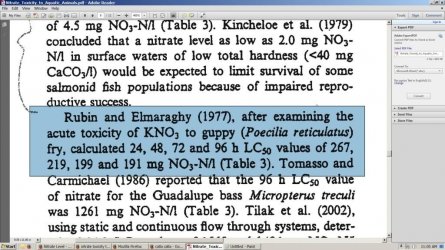As most members here know I like to search the research out there on a number of hobby related topics. This includes papers on ammonia and nitrite toxiicty as well as a number of other things. One of the hardest things to find is any decent information on nitrate and fish. Most of what is out there is not hugely helpful as it related to invert, insect and fish species which we never keep in tanks.
What one typically finds is something like this publish in May 2006:
Abstract
Water quality criteria for aquaculture systems have typically considered parameters such as temperature, dissolved oxygen, total gas pressure, ammonia, and nitrite. Many of the published criteria are derived for environmental protection of a wide range of species and life stages. These criteria may not be appropriate for a single species and life stage, especially in commercial applications. The value of a given water quality criterion may depend strongly on the species, size, and culture objectives. In water reuse systems, fine solids, refractory organics, surface-active compounds, metals, and nitrate may become important. The limiting factors in very high intensity reuse systems are not entirely understood at this time. Development of more relevant water quality criteria for reuse systems will require production-scale trials. Separate water quality criteria for biofilter operation are also needed.
from
http /www.sciencedirect.com/science/article/pii/S014486090500124X
/www.sciencedirect.com/science/article/pii/S014486090500124X
Bear in mind that you need to convert NO3 mg/l-nitrogen to the scale used on hobby tests like the API kit you must multiply the nitrogen number by 4.4. So the above
Now, if one wants to know how nitrate affects trout or salmon or daphnia in the wild, we can find that. But these species are generally known to be more sensitive to the nitrogen compounds than fish in general. So it doesn't help us much. There is some research into a few species we find in such as guppies. The one thing I do find is the belief that if you start with data for LC50 (i.e the level that kills 50% of the fish within X hours) that concentrations at 10% of that level are considered to be safe.
So look at this research into guppy fry which showed:

from
http /yaphankcivic.org/uploads/Nitrate_Toxicity_to_Aquatic_Animals.pdf
/yaphankcivic.org/uploads/Nitrate_Toxicity_to_Aquatic_Animals.pdf
This means that, at the lowest value above of 191 mg/l-n which kills 1/2 the fish in 96 hours, 10% of this is 9.1 mg/l-n and would read 76.4 ppm on an API kit (assuming you got an accurate test result). That level is then considered safe and is a far cry from 10 or 20 ppm being harmful.
What is known about nitrate toxicity is that it is both species and life stage specific and does relate to other water parameters.
What I wonder is when people post that nitrate levels on our test kits need to be under a given level, on what is this opinion being based? Where is the data to support such statements? While I am willing to agree that lower levels of nitrate are safer than higher ones, I am not prepared to draw a red line which states any and all fish in our tanks must have less than 20, 40 or even higher on our hobby kits. Nitrate takes time to accumulate which means if one does weekly or more frequent water changes in a fw tank that the amount of time nitrate is at its highest level is not the whole week but is there at the end of the week.
Nor do I understand why 80 ppm would be OK for planted tanks but not for unplanted? This ignores any time factor. The day you dose nitrate is the day it is at maximum level. You add all 80 ppm. How long is it going to take the plants to reduce the nitrate level to 20 ppm or less. And until nitrate in that planted tank is actually reduced to 20 ppm, why isn't it harming fish? For a few days nitrate levels must be over 20 ppm. And either this is harmful or it is not, the plants change nothing in that respect.



 /www.sciencedirect.com/science/article/pii/S014486090500124X
/www.sciencedirect.com/science/article/pii/S014486090500124X
